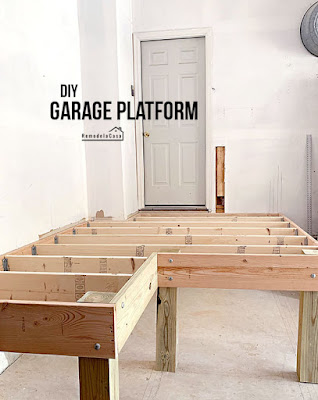The building process for this bench is surprisingly easy and economical.
With all the cabinets already in place—a shoe cabinet, cubbies, and a corner cabinet—it was about time to give this little build a go!
I used 3/4" plywood for the legs and top base, 1 x 2 pine for the front of the legs, and a 1x3 apron.
The benchtop was made of poplar. I bought a 1 x 10 x 10 board cut to size.
I added a mini board-and-batten wall using 1 x 4 pine boards.
I used a sawdust and wood glue mix to cover the nail holes and gaps.
I was still deciding about adding shiplap here. Ultimately, I gave up and used it to eliminate the leftover 1/4" ply I've had for years!
The tedious part of this entire mudroom project has been patching, sanding, and painting.
Good thing Kilz primers are always an excellent base for a well-done painting job.
This is how it looked at the end of the day. 😍
Here, looking the other way.
The next part is building and installing the doors and making that empty wall on the right look like a cabinet.
Thanks for stopping by!
With all the cabinets already in place—a shoe cabinet, cubbies, and a corner cabinet—it was about time to give this little build a go!
I used 3/4" plywood for the legs and top base, 1 x 2 pine for the front of the legs, and a 1x3 apron.
The benchtop was made of poplar. I bought a 1 x 10 x 10 board cut to size.
*This post contains affiliate links for your convenience. Click here to read my full disclosure policy.
Here's the cutting list for this bench:
1 - 3/4" plywood @ 14" x 42" (benchtop base)
1 - 1 x 9 1/4" x 42" poplar (benchtop)
1 - 1 x 5 1/2" x 42" mitered alongside (bench top)
1 - 1 x 1 1/2" x 42" mitered alongside (bench top - front)
3 - 3/4" plywood @ 14" x 16 1/2" height (legs)
3 - 1 x 2 pine @ 14" ( front of legs)
1 - 1 x 3 pine @ 42" (bench apron)
Tools & other materials you'll need:
Directions
1. INSTALL THE LEGS
Given that I had an enclosed area for this bench, both exterior legs were secured first to the studs on the wall using 2 1/2" screws and then to the cabinet using 1 1/4" wood screws.
Find the center of the benchtop plywood piece and attach the remaining leg there, using 1 1/4" wood screws.
Bring that base/center leg and install it, driving 1 1/2" brad nails from the top to the bottom legs on both sides.
2. INSTALL THE FACE FRAME
Center the 1 x 2 on the front of the legs and set it in place with brad nails. Install the apron above.
3. CUT AND INSTALL THE BENCHTOP
I used a 1 x 10 x 10' poplar board for the benchtop. Both small front boards were mitered to give it the illusion of a single chunky board.
Before installing it, I gave it a Varathane white-wash wood stain coat.
It was secured to the plywood base with 1 1/2" brad nails.
1 - 3/4" plywood @ 14" x 42" (benchtop base)
1 - 1 x 9 1/4" x 42" poplar (benchtop)
1 - 1 x 5 1/2" x 42" mitered alongside (bench top)
1 - 1 x 1 1/2" x 42" mitered alongside (bench top - front)
3 - 3/4" plywood @ 14" x 16 1/2" height (legs)
3 - 1 x 2 pine @ 14" ( front of legs)
1 - 1 x 3 pine @ 42" (bench apron)
Tools & other materials you'll need:
- Drill
- Brad Nailer with 1 1/2 brad nails
- 3 - 2 1/2" screws
- 3 - 1 1/4" wood screws
- wood glue
- a wood stain of your choice/paint & primer
Directions
1. INSTALL THE LEGS
Given that I had an enclosed area for this bench, both exterior legs were secured first to the studs on the wall using 2 1/2" screws and then to the cabinet using 1 1/4" wood screws.
Find the center of the benchtop plywood piece and attach the remaining leg there, using 1 1/4" wood screws.
Bring that base/center leg and install it, driving 1 1/2" brad nails from the top to the bottom legs on both sides.
2. INSTALL THE FACE FRAME
Center the 1 x 2 on the front of the legs and set it in place with brad nails. Install the apron above.
3. CUT AND INSTALL THE BENCHTOP
I used a 1 x 10 x 10' poplar board for the benchtop. Both small front boards were mitered to give it the illusion of a single chunky board.
Before installing it, I gave it a Varathane white-wash wood stain coat.
I added a mini board-and-batten wall using 1 x 4 pine boards.
I used a sawdust and wood glue mix to cover the nail holes and gaps.
I was still deciding about adding shiplap here. Ultimately, I gave up and used it to eliminate the leftover 1/4" ply I've had for years!
The tedious part of this entire mudroom project has been patching, sanding, and painting.
Good thing Kilz primers are always an excellent base for a well-done painting job.
This is how it looked at the end of the day. 😍
The next part is building and installing the doors and making that empty wall on the right look like a cabinet.
Thanks for stopping by!
-------------------- . * . * . * . * . * . -------------------
Here are all the projects that were tackled during this mudroom build:
*This post contains affiliate links.

























It is looking so good Cristina, love the mitered detail and natural color of the bench!
ReplyDelete